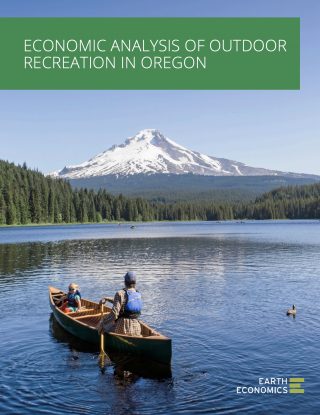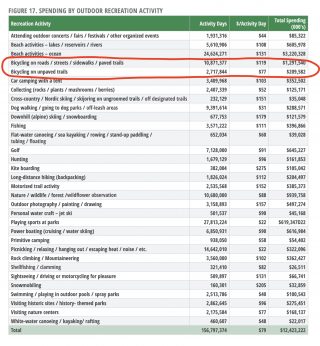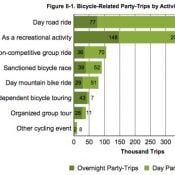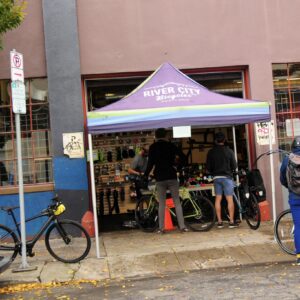
(Photo: Jonathan Maus/BikePortland)

An in-depth analysis of spending in Oregon found that cycling is one of the most economically valuable forms of outdoor recreation in the state.
The Outdoor Recreation Economic Impact Study released last week by Travel Oregon (in partnership with the Oregon Parks and Recreation Department, Oregon Office of Outdoor Recreation, Oregon Fish and Wildlife and Earth Economics) found that in 2019 outdoor recreation supported more than 224,000 jobs statewide and generated $9.3 billion in wages and compensation. The study also found that in 2019, outdoor recreation in Oregon supported $15.6 billion in spending, which includes everything from trip-related spending (money spent on recreational trips), to expenditures on equipment-related spending (outdoor recreation gear, apparel, equipment, and repair).
The study was done to give local leaders more information about the value of outdoor recreation and help them tailor projects, policies, and programs to encourage more of it. The State of Oregon sees outdoor recreation as a valuable asset — for both tourists and locals — that can boost economies in cities large and small. Activities were separated into 32 categories and the study focused on three major data points: total number of days spent doing each activity, spending on trips, and spending on equipment.
When the receipts were tallied, bicycling was at the top no matter how you look at the numbers.
Advertisement

The two bicycling-related categories (split into paved and unpaved) combined for 13.4 million “activity days” — fourth highest among the 32 recreational activity categories. The study counted more people bicycling than golfing (7.1 million), hunting (1.7 million), and rock/mountain climbing (3.5 million) combined.
Bicycling accounted for the third highest amount of spending per day — $196 — behind only kiteboarding and snowmobiling. In total, bicycling accounted for over $1.5 billion in total spending, second among all activities and only behind the “Beach activities – ocean” category.
If you’re curious how this shakes out in a real-world example, the study shared a sample profile of a “local park recreationist” that happened to be a bicycle rider:
A Portland resident gets off work, immediately hops on his recently acquired bike and meets up with his friend for a ride around Forest Park – a Wednesday tradition. More often than not, tradition holds that they have an after-ride beer when they get back to the city. Stopping by the brewery, they spend five bucks on beer and hit the nearby food truck. While these purchases seem small and insignificant, adding up to a little less than $15 by each, the cumulative impacts of thousands of individuals taking part in similar traditions add up to real income for the brewer and the food truck operator. The food truck worker and brewery server earn wages which are then re-spent on living expenses. Further, the hop farmer in the mid-Willamette Valley relies on brewers in Portland selling their beer so they continue to place orders. What all started as a simple evening tradition sets off a chain reaction of economic effects.
This study is a great resource for planners and policymakers. It’s also excellent news for cycling advocates who want the state to pay more attention to their needs.
Learn more about the study and download a copy of the report at TravelOregon.com.
— Jonathan Maus: (503) 706-8804, @jonathan_maus on Twitter and jonathan@bikeportland.org
— Get our headlines delivered to your inbox.
— Support this independent community media outlet with a one-time contribution or monthly subscription.






Thanks for reading.
BikePortland has served this community with independent community journalism since 2005. We rely on subscriptions from readers like you to survive. Your financial support is vital in keeping this valuable resource alive and well.
Please subscribe today to strengthen and expand our work.
This should give any politician pause before not supporting a trail in their area. Multiple economic analyses across the country over years have shown how trails are catalysts for a lot of economic development. Get over the hump of a few local detractors and the benefits are enormous.
Won’t you think of all the salmon and elk? What about them? Or the frogs that might get stuck in the mountain bike tracks? /s
I think my friend ran over maybe 5 snakes riding the GAP/C&O. They were ubiquitous. On the one hand, I see hiking advocates point of protecting the environment. There are some places that have minimum tire width to protect undergrowth etc. I’d get on board with that. On the other hand, restricting car access to more areas of the National Forest would serve the same function by exponential factors. Riding places like St. Helens I saw virtually zero garbage. Every time I start seeing trash, I know I’m getting close to a hiway.
Now if only the hiking advocates could provide science to back up their ubiquitous claims about the damage mountain biking does to the environment. The cycling advocates also want to protect the environment, we just follow the science.
I ride all over and the hikers usually tend to be the ones doing most of the trail damage, littering, not sharing the trail well, etc. Wish they could at least share.
People ride bikes in Forest Park?
Only males whose jobs include acquiring bikes: “A Portland resident gets off work, immediately hops on his recently acquired bike…”
Apparently only males whose jobs include acquiring bikes:
“John” (not his real name), a long-time Portland resident gets off work in the local tourist industry where he engages all day in the secondary and tertiary bike frame and parts industry, immediately hops on his recently acquired bike, borrowed no doubt from an unknown negligent previous user who only secured it with a U-lock, easily cut with John’s handy dandy angle-grinder. And he meets up with his friend “Fred” for a ride around Forest Park to check on their grow operations – a Wednesday tradition. More often than not, tradition holds that they have an after-ride beer when they get back to the city, before they head to their recreational urban campground and industrial work site. Stopping by the brewery, they spend five bucks on beer and hit the nearby food truck, taking all the cash from the poor owner.
That seems both overly optimistic and off by a couple of zeros.
If you have research on this that suggests otherwise please share.
It sounds to me like they lumped both direct and indirect costs together to come up with that inflated figure. Just because you take your bike with you on vacation and use it once or twice doesn’t mean that every tank of gas you buy, hotel room you rent or meal you eat should be counted as ‘bicycle tourism’.
The methodology uses the “primary trip purpose” so “taking your bike on vacation and using it once or twice,” would not be primarily a “bicycling vacation”. Going camping and bringing bikes along and riding at the campground would be under “car camping with a tent.”
“Indirect effects are the impacts that are driven by business-to-business transactions. For instance, hotels need fresh linens, restaurant owners purchase meat, dairy and vegetables, and river fishing charters buy fishing gear. This secondary spending creates additional economic contributions and impacts.”
Separating direct and indirect effects would be incredibly tricky. Note the public health, environmental, climate, etc. benefits were not considered. Other research has attempted to tackle the public health benefits alone and they are enormous.
Interesting in that college football statewide contributes only about $300 million to Oregon’s economy (2017 figures). And look how much is spent on subsidizing college football. The U of O’s luxurious Autzen stadium is used for only 6 days a year!
For 2018 The Ducks made $92 million in revenue and $54 million in profit from their football program.
The Universities believe (and they may be correct) that popular sports bring in donor money.
Single-use stadiums are a huge waste of resources, though. I think most people would agree on that point.
I’m not surprised by this data. My wife and take our bicycles on all the vacations we take in state. We stay at hotels, eat at restaurants, etc. in Bend, Ashland, Oakridge, Wine country, Corvallis and more (At least we did before covid) and ride our bikes. I see a lot of people with out of state license plates in the same areas.
If you ride mountain bikes you are aware of all the guides, shuttle services (not my thing), demo days, etc. If you ride road bikes think Cycle Oregon and things like the car free days at Crater Lake and the McKenzie HW after the snow is clear and before cars are allowed.
Yep, and this is even without a system of regional trails. Look at budgets for people riding the GAP/C&O and the Empire State Trail (formerly Erie Canal). Thousands of people ride them spending hundreds of millions of dollars a year.
The new Hyatt Regency hotel is sitting empty and dark on the other side of the MAX tracks from the extremely quiet convention center, one of many local hotels that are showing about 18% average occupancy. Think of that as a 400 calorie diet. There’s at least one more big new hotel under construction downtown.
That’s a constituency for a regional bike trail network if anyone could sell it to them. Or, maybe we should just wait for the convention business to come back, after this particular pandemic tapers off? Disaster tourism is also a thing…
Not all bike riders have $200 a night to spend on a hotel but the tourism and service industry economy we were about to have is going to need all the help it can get after 2020-21.
The relative popularity of cycling to other activities is no surprise, but 1.5 billion in a population works out to $364 for every man woman and child in the state whether or not they own a bike.
This value is highly suspect as is the notion that people riding bikes around generate considerably more revenue per activity day than golf (a notoriously expensive sport) and roughly as much as several motorsports.
If you have data to support your opinion, please share. Please look at the studies (above) of revenue from single trails which often reach hundreds of millions per year, rather than an entire state. Anecdotally, I spent at least $7k last year on bike equipment/trips in Oregon alone. Add a few $k for trips outside Oregon.
I spent a thousand or more on post-ride beers alone!
I usually put that under “parts and equipment.”
The data I’m using is the report presented in this article.
What’s there makes sense in terms of general level of cycling. It’s high relative to other activities, but only works out to 2 1/2 days per year per capita in the state — which sounds about right given what percentage of people actually ride and when.
Your costs are extremely high and well beyond what the vast majority of people could handle. I am curious as to how exactly they come up with single trails generating hundreds of millions in revenue. That would mean if you have a million people on the trail, it would work out to hundreds per capita. Those are really weird people and a trail that’s so crowded I can’t see the point of being on it. I’m a lifetime outdoorsman and while I do own some gear, I’ve had it for many years. The only real cost for a trip is transport.
Cycling is not the only activity with highly suspect values. I do quite a few of the things listed and there’s no way any one of them is anywhere close. $31 per activity day of dog walking? More than $150 to ski on your own? Yah, right.
I would simply suggest read the research yourself if you remain incredulous. I don’t expect to persuade you. Here’s an old study on the GAP. Here’s the economic impact of Erie Canal trail. Here is a news article from PA on the economic impact on the state with only rail trails considered totaling close to $1 billion.
To summarize, you’re suggesting that a trail that creates hundreds of millions in revenue doesn’t mathematically require a ridiculous number of people who spend an inconceivable amount of money, and that the typical day out costs more than taking out jet skis by a considerable margin?
Look up Brandolini’s Law if you’re not familiar– I’m not falling for it
LOL. I wish I could have used that argument to avoid doing research in grad school. “But sir reading research and using science is mathematically ridiculous! I’m just not falling for it.” Brandolini’s Law applied originally to Berlusconi and a political talk show, not science. Science and critical thinking requires a lot of failed hypotheses and effort. One easy way to avoid this effort is to make a pseudoscientific theory that everything you disagree with is bullshit.
How is the $/Activity day actually calculated in that chart? It doesn’t make sense to me based on the other numbers provided.
Can you be more specific? Not sure what you mean.
Sure – how do you reproduce that number? What numbers are they using to come up with it? It says $/Activity day – but if you divide $ by activity days, it is nowhere near that.
Oh, ok I see what you’re saying I think. So for “Attending outdoor concerts” there was around 1,931,316 total “activity days.” People who attended concerts typically spent on average around $44 associated with that activity. So multiply those together to get the total spending: $84,977,904. The chart is a little confusing (000’s). Hope that helps.
Right – and that number doesn’t match.
You’re talking about the ~$300,000 discrepancy? I have to assume they’re using rounded numbers. If you have an issue with that, perhaps email the authors for the original data.
Yea – they all seem a bit off, but sort of close. Kind of a strange rounding error, but none too far out of bounds.
I say good eye! And keep em honest. Stats can be wildly misleading when not given in a transparent manner. Source data should always be public, and an explanation of this discrepancy really should be in the report, so go for it.
Health benefits of increased biking and walking are significant.
Yes, indeed. And those health benefits were not included in the actual economic benefits of this study. They were merely alluded to based on other studies.
“Those who participate in outdoor recreation are shown to have lower medical and insurance costs than their non-active counterparts. Researchers from Oregon State University estimated the economic value of this physical activity to be $1.4 billion in insurance savings. These savings reduce total health care expenditures by 2-3.6% statewide.”